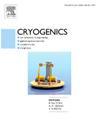Intermittent operation of flux pump to maintain persistent current mode in high-temperature superconducting magnets
IF 2.1
3区 工程技术
Q3 PHYSICS, APPLIED
引用次数: 0
Abstract
The high-temperature superconducting (HTS) travelling-wave flux pump is a groundbreaking power source designed for wirelessly supply power to HTS magnets. The physical origin of its DC voltage is the macroscopic magnetic coupling effect. It can entirely replace traditional contact-type power supplies and their current leads which add thermal load. Currently, when HTS travelling-wave flux pumps sustain the Persistent Current Mode (PCM) in HTS magnets, it is unavoidable to have AC losses within the HTS magnets. These losses increase the demand on the cooling system and compromise the precision of the controlled current. This paper achieves the intermittent operation of the flux pump by simultaneously switching on-off the AC travelling magnetic wave and DC bias magnetic field of the linear-motor type flux pump through closed-loop feedback control. This control method stabilizes the flux pump’s output current within a specific range, thereby maintaining the PCM in the HTS magnet. The benefit of this control strategy is enhanced current control precision and reduced system operational energy consumption. In the experiments conducted in this study, for an HTS magnet with an inductance of 1.31 mH operating at a temperature of 77 K, maintaining the load current at 77 %Ic (i.e. 60 A), the reduction in the current ripple factor is to 3.3 ‰, a 34 % improvement over the 5 ‰ ripple factor when only the DC bias magnetic field was controlled for feedback. Additionally, the flux pump’s operation duty cycle is 12.5 %, representing an 89 % decrease in energy consumption compared to the previous setup where only the DC bias coil was controlled.
在高温超导磁体中间歇运行磁通泵以保持持续电流模式
高温超导行波磁通泵是一种开创性的为高温超导磁体无线供电的电源。其直流电压的物理来源是宏观磁耦合效应。它可以完全取代传统的接触式电源及其增加热负荷的电流引线。目前,当高温超导行波磁通泵在高温超导磁体中维持持续电流模式(PCM)时,高温超导磁体内部不可避免地存在交流损耗。这些损耗增加了对冷却系统的要求,并损害了控制电流的精度。本文通过闭环反馈控制,将直线电机型磁通泵的交流行波和直流偏置磁场同时通断,实现磁通泵的间歇运行。这种控制方法将磁通泵的输出电流稳定在一个特定的范围内,从而保持高温超导磁体中的PCM。该控制策略的优点是提高了电流控制精度,降低了系统运行能耗。在本研究的实验中,对于电感为1.31 mH的高温超导磁体,工作温度为77 K,保持负载电流为77% Ic(即60 a),电流纹波因子降低到3.3‰,比仅控制直流偏置磁场反馈时的5‰纹波因子提高了34%。此外,磁通泵的工作占空比为12.5%,与之前只控制直流偏置线圈的设置相比,能耗降低了89%。
本文章由计算机程序翻译,如有差异,请以英文原文为准。
求助全文
约1分钟内获得全文
求助全文
来源期刊

Cryogenics
物理-热力学
CiteScore
3.80
自引率
9.50%
发文量
0
审稿时长
2.1 months
期刊介绍:
Cryogenics is the world''s leading journal focusing on all aspects of cryoengineering and cryogenics. Papers published in Cryogenics cover a wide variety of subjects in low temperature engineering and research. Among the areas covered are:
- Applications of superconductivity: magnets, electronics, devices
- Superconductors and their properties
- Properties of materials: metals, alloys, composites, polymers, insulations
- New applications of cryogenic technology to processes, devices, machinery
- Refrigeration and liquefaction technology
- Thermodynamics
- Fluid properties and fluid mechanics
- Heat transfer
- Thermometry and measurement science
- Cryogenics in medicine
- Cryoelectronics
 求助内容:
求助内容: 应助结果提醒方式:
应助结果提醒方式:


